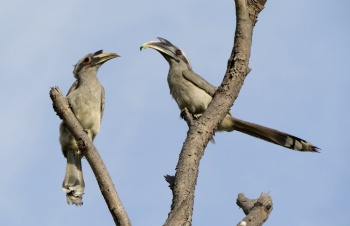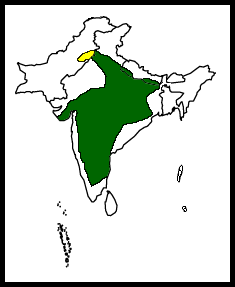Alternative name: Common Grey Hornbill
- Ocyceros birostris
Identification
With 50cm (19¾ in) a small, silvery-grey and white Hornbill.
- Brownish grey (north) to light grey (south) body with dull white belly
- Long tail
- Male with blackish bill and narrow casque with protruding front edge, bill tip and part of lower mandible yellow
- Grey bare skin around eye, eyes red-brown
- Female smaller, casque less protruding, browner iris
- Juveniles without casque, bill small and pale yellow
Similar species
Can only be confused with Malabar Grey Hornbill in the Western Ghats, but Malabar doesn't have a casque and the bill is orange-yellow.
Distribution
| Mainly found in India, also in the southern-most parts of lowland Nepal and a summer visitor to north-eastern Pakistan (mainly around Lahore) and north-western Bangladesh. Common in most parts of its range. | |
| Legend • O. birostris; year-round |
Taxonomy

Photo © by Alok Tewari
Haridwar, Himalayan Foothills, Uttarakhand, India, August-2015
This is a monotypic species[6].
The genus Ocyceros is sometimes included in genus Tockus.
Habitat
Wide variety of habitat. Prefers deciduous forest, parkland and open thorn-forest with fig trees. Also around rural cultivation and in gardens.
Behaviour
Diet
Feeds mainly on fruits (especially figs), but takes also insects, lizard, mice and nestlings of other species. Often seen flying from tree to tree, sometimes on the ground.
Breeding
Breeding at the end of the dry season, mainly February or May to June.
They usually form their nest in tree holes. The female stays inside the nest and seals the nest hole with droppings and food leaving only a small hole. Sometimes the male also delivers some mud. Lays 2-5 eggs. While inside the nest, the female will pluck out all her feathers and throw them outside the nest so that it can maintain the required space along with the growing chicks. The regrowth of the feathers in the female coincides almost with the maturity of the chicks at which point the nest is broken open. Possibly this species is a co-operative breeder with additional males helping to feed.
Movements
Generally a resident species but food-related movement can occur. Then seen in small flock with up to 30 birds.
Vocalisation
Two individuals were sitting together, on top of a Eucalyptus tree, at day-break ; One of them was calling ; on the side of a very busy city road.
Recording by Alok Tewari
Delhi, India, Sept.-2010
References
- Rasmussen, PC and JC Anderton. 2005. Birds of South Asia: The Ripley Guide. Barcelona: Lynx Edicions. ISBN 978-8487334672
- Grimmett, R, C Inskipp, and T Inskipp. 1998. Birds of the Indian Subcontinent. London: Christopher Helm. ISBN 978-0713640045
- Kazmierczak, K and B van Perlo. 2000. A Field Guide to the Birds of the Indian Subcontinent. New Haven: Yale Univ. Press. ISBN 978-0300079210
- Kazmierczak, K and R Singh. 2001. A Birdwatcher's Guide to India. New Dehli: India Oxford Univ. Press. ISBN 978-1871104080
- Del Hoyo, J, A Elliot, and J Sargatal, eds. 2001. Handbook of the Birds of the World. Volume 6: Mousebirds to Hornbills. Barcelona: Lynx Edicions. ISBN 978-8487334306
- Clements, J. F., T. S. Schulenberg, M. J. Iliff, D. Roberson, T. A. Fredericks, B. L. Sullivan, and C. L. Wood. 2017. The eBird/Clements checklist of birds of the world: v2017, with updates to August 2017. Downloaded from http://www.birds.cornell.edu/clementschecklist/download/
- Wikipedia
Recommended Citation
- BirdForum Opus contributors. (2025) Indian Grey Hornbill. In: BirdForum, the forum for wild birds and birding. Retrieved 5 February 2025 from https://www.birdforum.net/opus/Indian_Grey_Hornbill
External Links
GSearch checked for 2020 platform.1







